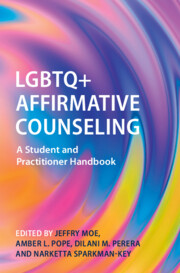Book contents
- LGBTQ+ Affirmative Counseling
- LGBTQ+ Affirmative Counseling
- Copyright page
- Contents
- Figure
- Tables
- Box
- Contributors
- Part I Foundations of LGBTQ+ Affirmative Counseling
- Part II LGBTQ+ Lifespan Development and Family Dynamics
- 5 Lifespan Development for Transgender and Gender-Diverse People
- 6 Sexual-Affectional Orientation Lifespan Development
- 7 Historical Perspectives on Gender Identity Development
- 8 Historical Perspectives on Sexual-Affectional Identity Development
- 9 Family and Relationship Dynamics and LGBTQ+ Mental Health
- Part III Assessment and Treatment in LGBTQ+ Affirmative Counseling
- Part IV New Directions in LGBTQ+ Affirmative Counseling
- Index
- References
5 - Lifespan Development for Transgender and Gender-Diverse People
from Part II - LGBTQ+ Lifespan Development and Family Dynamics
Published online by Cambridge University Press: 31 October 2024
- LGBTQ+ Affirmative Counseling
- LGBTQ+ Affirmative Counseling
- Copyright page
- Contents
- Figure
- Tables
- Box
- Contributors
- Part I Foundations of LGBTQ+ Affirmative Counseling
- Part II LGBTQ+ Lifespan Development and Family Dynamics
- 5 Lifespan Development for Transgender and Gender-Diverse People
- 6 Sexual-Affectional Orientation Lifespan Development
- 7 Historical Perspectives on Gender Identity Development
- 8 Historical Perspectives on Sexual-Affectional Identity Development
- 9 Family and Relationship Dynamics and LGBTQ+ Mental Health
- Part III Assessment and Treatment in LGBTQ+ Affirmative Counseling
- Part IV New Directions in LGBTQ+ Affirmative Counseling
- Index
- References
Summary
In LGBTQ+- affirmative counseling, understanding the distinct lifespan development of transgender and gender-diverse people is crucial. Transgender and gender-diverse clients have unique and individual needs that require competent, supportive, and celebratory mental health practitioners. This chapter explores the lifespan of transgender and gender-diverse people from childhood to old age and death, the sociopolitical factors influencing transgender and gender-diverse people’s lives, relevant clinical applications, and the intersectionality of Black, Indigenous, and people of color’s identities and other nondominant identities within this group.
Keywords
- Type
- Chapter
- Information
- LGBTQ+ Affirmative CounselingA Student and Practitioner Handbook, pp. 75 - 92Publisher: Cambridge University PressPrint publication year: 2024

